实用旅游英语翻译(英汉双向)第九章 旅游景点公示语的
- 格式:ppt
- 大小:160.00 KB
- 文档页数:13

举世闻名的九寨沟自然保护区位于我国四川省境内,是一片纵深达35公里的自然风景区。
区内有终年积雪的山峰、苍翠繁茂的森林、宁静悠远的湖泊。
人们常常将九寨沟比作世外桃源。
Located in Sichuan Province, the World-famous Jiuzhaigou Nature Reserve covers an area of natural beauty 35 kilometers long. In the reserve there are perennially snow-topped mountain peaks, verdant and lush forests and stretches of serene lakes. Jiuzhaigou is often compared to a haven of peace, leaving behind nothing but earthly troubles and worries.九寨沟是水的天地,水构成了九寨沟最富魅力的景色。
九寨沟风景区内有许多清澈的湖泊,它们或隐匿于峡谷,或镶嵌于原始森林。
这些湖泊大小不一、形状各异,如同一面面镜子,闪耀着斑澜的光芒。
Jiuzhaigou is a world of water, which brings Jiuzhaigou its most enchanting views. Jiuzhaigou boasts many clear lakes, some of which are hidden in the valleys and some inlay the virgin forests. With a variety of shapes and sizes, these lakes look like (gleaming) mirrors projecting colorful light rings in the sunshine.四川素有“天府之国”的美称。
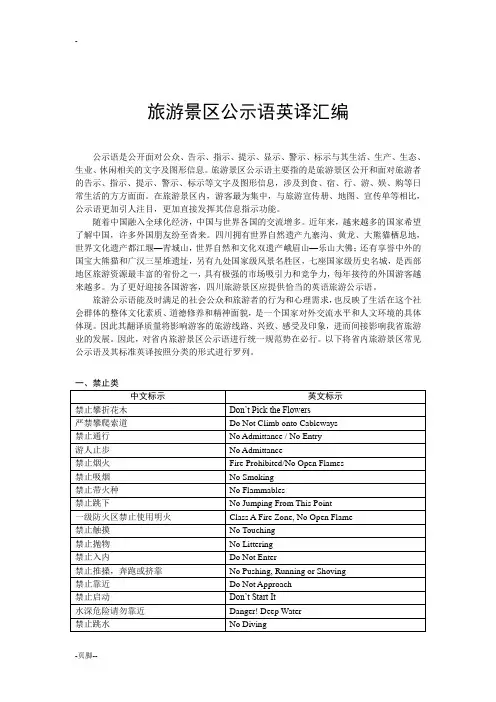
旅游景区公示语英译汇编
公示语是公开面对公众、告示、指示、提示、显示、警示、标示与其生活、生产、生态、生业、休闲相关的文字及图形信息。
旅游景区公示语主要指的是旅游景区公开和面对旅游者的告示、指示、提示、警示、标示等文字及图形信息,涉及到食、宿、行、游、娱、购等日常生活的方方面面。
在旅游景区内,游客最为集中,与旅游宣传册、地图、宣传单等相比,公示语更加引人注目,更加直接发挥其信息指示功能。
随着中国融入全球化经济,中国与世界各国的交流增多。
近年来,越来越多的国家希望了解中国,许多外国朋友纷至沓来。
四川拥有世界自然遗产九寨沟、黄龙、大熊猫栖息地,世界文化遗产都江堰—青城山,世界自然和文化双遗产峨眉山—乐山大佛;还有享誉中外的国宝大熊猫和广汉三星堆遗址,另有九处国家级风景名胜区,七座国家级历史名城,是西部地区旅游资源最丰富的省份之一,具有极强的市场吸引力和竞争力,每年接待的外国游客越来越多。
为了更好迎接各国游客,四川旅游景区应提供恰当的英语旅游公示语。
旅游公示语能及时满足的社会公众和旅游者的行为和心理需求,也反映了生活在这个社会群体的整体文化素质、道德修养和精神面貌,是一个国家对外交流水平和人文环境的具体体现。
因此其翻译质量将影响游客的旅游线路、兴致、感受及印象,进而间接影响我省旅游业的发展。
因此,对省内旅游景区公示语进行统一规范势在必行。
以下将省内旅游景区常见公示语及其标准英译按照分类的形式进行罗列。
三、指示类。
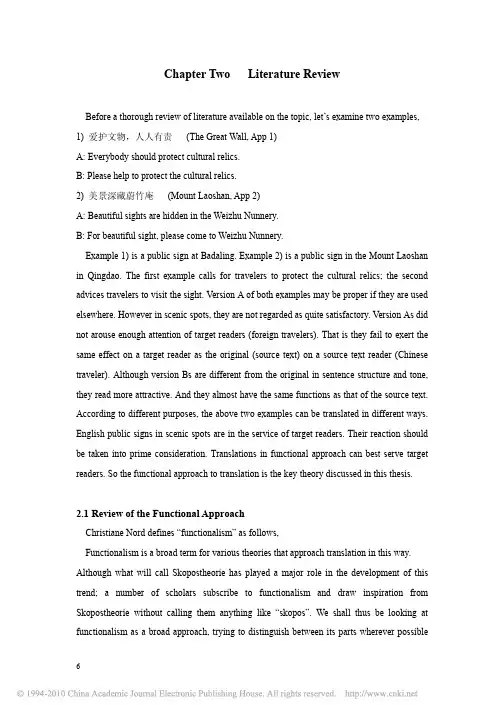
Chapter Two Literature ReviewBefore a thorough review of literature available on the topic, let’s examine two examples, 1) 爱护文物,人人有责 (The Great Wall, App 1)A: Everybody should protect cultural relics.B: Please help to protect the cultural relics.2) 美景深藏蔚竹庵 (Mount Laoshan, App 2)A: Beautiful sights are hidden in the Weizhu Nunnery.B: For beautiful sight, please come to Weizhu Nunnery.Example 1) is a public sign at Badaling. Example 2) is a public sign in the Mount Laoshan in Qingdao. The first example calls for travelers to protect the cultural relics; the second advices travelers to visit the sight. Version A of both examples may be proper if they are used elsewhere. However in scenic spots, they are not regarded as quite satisfactory. Version As did not arouse enough attention of target readers (foreign travelers). That is they fail to exert the same effect on a target reader as the original (source text) on a source text reader (Chinese traveler). Although version Bs are different from the original in sentence structure and tone, they read more attractive. And they almost have the same functions as that of the source text. According to different purposes, the above two examples can be translated in different ways. English public signs in scenic spots are in the service of target readers. Their reaction should be taken into prime consideration. Translations in functional approach can best serve target readers. So the functional approach to translation is the key theory discussed in this thesis.2.1 Review of the Functional ApproachChristiane Nord defines “functionalism” as follows,Functionalism is a broad term for various theories that approach translation in this way. Although what will call Skopostheorie has played a major role in the development of this trend; a number of scholars subscribe to functionalism and draw inspiration from Skopostheorie without calling them anything like “skopos”. We shall thus be looking at functionalism as a broad approach, trying to distinguish between its parts wherever possibleand necessary (Nord, 2001: 1)From what Nord defines in her book, we may understand that functionalism is a broad concept, pooling together a variety of scholars and theirs approaches to translation. Functional approach includes the German school with Katharina Reiss as the founder, British scholar Peter Newmark and his semantic vs. communicative translation as well as American scholar Eugene. A. Nida and his functional equivalence.In the German school the best known names are Katharina Reiss, Hans J. Vermeer and Christiane Nord. As founder of Skopostheorie, Reiss first established a general relationship between translation strategies and text functions. Reiss’s student Vermeer put forward the concept of Skopostheorie. He defines that every translation is directed at an intended audience, since to translate means “to produce a text in a target setting for a target purpose and target addressees in target circumstances”. (Nord, 2001: 12). Later on Nord put forward the rule of “Function plus Loyalty” with regard to the limitation of Skopostheorie and the problems of radical functionalism.Peter Newmark suggests three main textual functions: informative, expressive and vocative. Different text types require different translation strategies. Semantic translation is used for expressive texts; communicative translation is used for informative and vocative texts. Of vocative texts he put forward the focus of translation is the readership. In translating informative and vocative texts, the translator is supposed to produce a version which is readily acceptable and comprehensible to the readership both in content and language and he /she is justified to improve the original text if it is poorly translated. (Newmark, 1981: 42) This provides useful guidelines for the translation of public signs, which fall in to the categories of informative and vocative texts.According to Eugene Nida, the governing principle of dynamic equivalence is to “reproduce in the receptor language the closest natural equivalent of the source language, first in terms of meaning, and secondly in terms of style” (Nida and Taber, 2004: 12) He explains it is essential that the target text functions in the same manner as the source text. The target readers are able to respond to it in substantially the same manner as the source text readers respond to the original text.In the following passages, the German school and Peter Newmark’s theory would bediscussed in detail.2.2 The Functional Approach2.2.1 Katharina Reiss and Her Text Typology TheoryIn 1971, Reiss in her book Possibilities and Limits of Translation Criticism developed a model of translation criticism based on the functional relationship between source and target texts. To her target text should be equivalent to source text in terms of conceptual content, linguistic form and communicative function. From this point we can see that she still took equivalence as the basis. However, in practice “she knew that real life presents situations where equivalence is not possible and in some cases, not even desired. (Nord, 2001: 9) Especially, when the target is intended to achieve a purpose or function other than that of the original. “In such a situation, she thinks that the functional perspective takes precedence over the normal standards of equivalence. Then translation critic can no longer rely on features derived from source-text analysis but has to judge whether the target text is functional in terms of the translation context”. (Nord, 2001: 9)Reiss is also aware that it is the overall text type, rather than the subdivisions that decide the type of equivalence to be sought and the translation strategy to be followed. If the text function is to provide information, then content must be preserved at all cost, and any “flourishes of style” can safely be sacrificed to that purpose, so that the translation method will be “plain-prose”. When there is a conflict between the functions of the ST and the TT, Reiss uses an “author-adapted” translation method to produce the same or at least a similar effect.She further divides text into three main types as content-focused text, form-focused text and appeal-focused text. Reiss generalizes her typology theory in the following form, (Reiss, 2000: 26)language function representation expression persuasion language dimension logic esthetics dialoguetext type content-focused(informative) form-focused(expressive)appeal-focused(operative)Content-focused text emphasizes content and the form is comparatively less important. When such a text is translated, the original information should be retained as intact as possible and the linguistic form of the translation should be adjusted to the target language conventions. For expressive text, form plays a vital role. Authors of form-focused texts such as literary prose and poetry often employ some formal elements to attain the original aesthetic effect. They should use similar form in translation to produce corresponding impression. The third type is appeal-focused text. This type intends convey information or provoke certain reaction. The translation must undergo certain adaptation to match the target language and the target culture.However there is not a pure informative, expressive or persuasive text. Reiss states that “…a further point should be clarified. If we draw a distinction between content-focused and from-focused text, this is not to imply that content-focused text do not have a form. Just as there can be no form of communication without some kind of content, there can be no kind of content that does not have some form.” (Reiss, 2000: 28) This is quite applicable for C-E translation of public signs which fall somewhere between informative and evocative (operative) text.Reiss’s text typology shed light on C-E translation of public signs. As one of foreign publicity material, public signs are classified as both the informative and evocative (operative) texts. Typology theory is particular valuable for the translators of public signs. They are encouraged to shift from the locking chains imposed by source text. The translators can hold a balance while selecting appropriate strategies to cope with various translation problems.2.2.2 Hans. J. Vermeer and His SkopostheorieSkopos is a Greek word for ‘purpose’. According to Skopostheorie, the prime principle determining any translation process is the purpose (skopos) of the overall translation action. (Nord, 2001: 27)Skopostheorie first assumes that translation must be a purposeful human activity. The purpose has three explanations: the translator’s purpose; the communicative purpose of the translated text; and the purpose to reach by exploiting certain special translation method. Usually the communicative purpose is the main purpose of the translated text.Skopostheorie also defines an intratextual coherence and intertextual coherence. Intratextual coherence implies a translation should be acceptable when it is coherent with the norms of the target culture. A communicative interaction can only be regarded successful if the receivers interpret it as being sufficiently coherent with their situation. (Nord, 2001: 32) For intertextual coherence, a translation is expected to bear some kind of relationship with the corresponding source text. Intertexual coherence should exit between source and target text. (Nord, 2001: 32) Intertextual coherence is considered subordinate to intratextual coherence and both are subordinate to the skopos rule. (Nord, 2001: 33)The theory prescribes a mode of thinking that will allow the translator to explore new approaches to the task of producing a successful target text. The theory particularly emphasizes target-orientation of translation. And it also stresses the translation situation which always determines the translation strategies to be used.This rule is intended to solve the eternal dilemmas of free vs. faithful translation, dynamic vs. formal equivalence, good interpreters vs. slavish translators and so on. It means that the skopos of a particular translation task may require a ‘free’ or a ‘faithful’ translation, or anything between these two extremes, depending on the purpose for which the translation is needed. (Nord, 2001: 29)Skopostheorie bears on C-E translation of public signs. Nord points out that “a text is made meaningful by its receiver and for its receiver.” (Nord, 2001: 31) The reaction of target readers’ should be taken into prime consideration. That is translation of public signs should be target-reader oriented.2.2.3 Christiane Nord and Her “Functions plus Loyalty”Christiane Nord further develops functional theory in the early 1990s and puts forward a rule of “Functions plus Loyalty”.Nord indicates that “My personal version of the functionalist approach stands on two pillars: function plus loyalty. Function refers to the factors that make a target text work in the intended way in the target situation. Loyalty refers to the interpersonal relationship between the translator, the source-text sender, the target-text addresses and the initiator. (Nord, 2001: 126). She holds that the translator should be responsible bilaterally for the target reader aswell as the original author. The translator should respect the source text producer and try to adjust the purpose of the target text and the source text author’s intention. The notion of loyalty not only means conveying the content and style of the source text, but also proposes necessary adaptation based on the source text in order to achieve the intended function of the target text, such as in the case of pragmatic translation. (Chen Xiaowei, 2006: 17) The principle of loyalty limits the range of justifiable target-text functions for one particular source text and raises the need for a negotiation of the translation assignment between translators and their clients. (Nord, 2001: 126). Thus the loyalty principle reduces the probability of “radical” functionalism. It is also an answer to those critics who argue that the functional approach leaves translators free to do whatever they like with any source text.The combination of function plus loyalty further improved the Skopostheorie. It grants translators some liberty in the translation process to achieve the intended function of the target text. Meanwhile it also keeps them from going far away from the original author’s intention. Moreover, Nord also proposes her documentary and instrumental translation. Documentary translation and instrumental translation are different in their emphasis on the source text and the target text. The former focused on source text, translators try to keep the language features or culture of the source text in the translated version, so this strategy is used with the classic works or serious literature. The latter resembles domestication translation, which produces equivalent effect by cultural adaptation; the target readers generally can not feel the text is a translation. The criterion for judging whether it is documentary or instrumental translation is that “the target audience is supposed to be aware or not they are reading a translation” (Nord, 2001: 50)According to Nord’s theory, translators of Chinese public signs should always bear in mind the priority of target text readers. Public signs should be translated according to the specific target functions. However it does not mean that translators have the right to change the functions at will. Any translation, regardless of its different specific purposes, should be based on the source texts.2.3 Peter Newmark and His Semantic vs. Communicative TranslationPeter Newmark’s major contribution to functionalism is his semantic translation versuscommunicative translation. “Communicative translation attempts to produce on its readers an effect as close as possible to that obtained on the readers of the original. Semantic translation attempts to render, as closely as the semantic and syntactic structures of the second language allow, the exact contextual meaning of the original” (Newmark: 1981: 39)It is quite obvious that communicative translation focuses on producing similar effect on the target readers. On the contrary, semantic translation remains within the original language convention and culture. He proposes that semantic translation is used for expressive texts and communicative translation for informative and vocative texts. That is in translating expressive texts, the expressive components should be rendered completely, original culture tend to be transferred intact and even badly and/or inaccurately written passages must remain so. However, for informative and vocative texts, the translator should focus on the accuracy of message and the main function of the source text, trying to produce an equivalent effect on target readers.He also proposes that different texts require different translation criteria and methods. He points out that for informative and vocative text the core is the accuracy of information and the readership. Accessibility and comprehensibility of the translation is very important as the reader does not anticipate difficulties or obscurities and would expect a generous transfer of foreign elements into his own culture as well as his language where necessary. (Newmark, 1981: 39)Peter Newmark’s theory also shed light on C-E translation of public signs. The translator is supposed to use language forms which read naturally to the target reader and he/she is entitled to improve the original text if it is badly and/or inaccurately written. Public signs should not be translated mechanically without an eye to the effect of the target texts on the target readers. Newmark’s semantic vs. communicative translation share some similarities with Nord’s documentary vs. instrumental translation. Semantic and documentary translations remain with the original linguistic and cultural conventions, while communicative and instrumental translations are target language oriented. But their difference is also quiet obvious. Nord holds that the skopos of the translation determines the choice of translation strategies, while Newmark proposes that the choice of translation methods is determined by the source text. However in translation practice, the methods of translation are not determined by the functionof the source text, but that of the target text. Very frequently the translation involves substantial adaptation of the source text in order to achieve the intended function of the target text.2.4 Enlightenments of the Functional Approach on C-E Translation of Public SignsAccording to Newmark’s typology (Newmark, 1981: 15), the features of public signs can be summarized from the functionalist point of view in the following graph.Functional analysis of Chinese public sings and English public signsNotes:1. Cpb: Chinese public signs; Epb: English public signs2. Culture, “low” means there are not many culture elements in public signs.3. Politeness, “low” means the public signs which do not read polite.The above graph gives us a general idea of the features of Chinese public signs and English public signs from the functional approach. Chinese public signs and English public signs are both in the service of their respective target readers. For most public signs, the source text and the target text share the same functions, informative, evocative or a combination of the two. There are other public signs: the function of the target text is different from that of the source text. An evocative public sign may be translated into an informative one or vice versa.This is because Chinese and English are different in language conventions and cultural traditions. Chinese public signs and English public signs differ in the ways they appeal to their respective readers. The source text readers (Chinese travelers) are prone to be affected by flowery expressions; while the target readers (foreign travelers) prefer more concrete information.Chinese public signs are therefore more descriptive. The language used is ornate and figurative, containing many flowery expressions like idioms or poems or quotations of famous persons’ remarks. English public signs are more informative. They read simple and concise. The language is plain and factual. When translating Chinese public signs into English, translators are usually required to apply various translation strategies, such as literal or liberal translation or adaptation.The main point of Skopostheorie is: it is the prospective function or skopos of the target text, not the source text that determines the translation process. Translators of public signs should apply various translation strategies in order to produce a version that will arouse the same effect on target text readers as that of the source text does on the source text readers.2.5 SummaryIn this part the writer discusses functional approach and its enlightenments on C-E translation of public signs. Reiss’s typology, Vermeer’s Skopostheorie, Nord’s function plus loyalty and Newmark’s semantic vs. communicative translation are the key theories involved in this chapter. According to the functional approach, it is the intended function of the target text that determines the overall translation process including the selection of translation strategies. The source text can’t be neglected either, as it serves as the main source of information. Translators of public signs should be aware of the status of target text readers. And the translations should always fulfill the need of target readers. The following chapter further explores the features and functions of public signs, giving us an insight on how functional approach applied to C-E translation in this area.Chapter Three A Functional Analysis of Public Signsin Scenic SpotsThe functional approach fits better in public signs translation as discussed in the previous chapter. The definition of a public sign, its categorization and the features are mainly discussed in the following paragraphs from the functional perspective.3.1 Definitions of Public SignsPublic signs are also called public notices, slogans, the languages of public notices, expressions on public signs.According to Longman Dictionary of Contemporary English1a sign is “a piece of paper, metal etc. in a public place with words or drawings on it that gives people information, warn them not to do something etc. e.g. a road sign, a no-smoking sign.”A Pubic sign can be defined as a piece of paper, metal or billboard in a public place with words or drawings on it that provides information or arouse people’s attention.The counterparts of public signs in Chinese are: 公示语、标志、标示语、告示语、标语、标牌语、标识. The most widely used one is “公示语”.Public signs and other related definitions in Chinese are as follows,1) 标语:用简短的文字写出的具有宣传鼓动作用的口号。
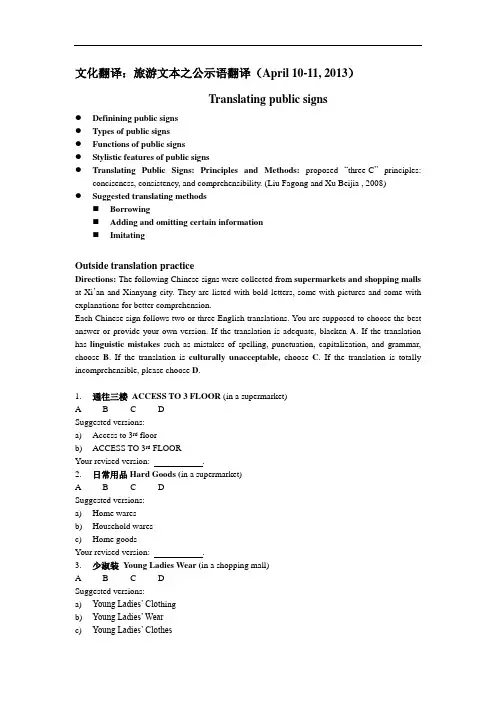
文化翻译:旅游文本之公示语翻译(April 10-11, 2013)Translating public signs●Definining public signs●Types of public signs●Functions of public signs●Stylistic features of public signs●Translating Public Signs: Principles and Methods: proposed “three-C”principles:conciseness, consistency, and comprehensibility. (Liu Fagong and Xu Beijia , 2008)●Suggested translating methods⏹Borrowing⏹Adding and omitting certain information⏹ImitatingOutside translation practiceDirections: The following Chinese signs were collected from supermarkets and shopping malls at Xi’an and Xianyang city. They are listed with bold letters, some with pictures and some with explanations for better comprehension.Each Chinese sign follows two or three English translations. You are supposed to choose the best answer or provide your own version. If the translation is adequate, blacken A. If the translation has linguistic mistakes such as mistakes of spelling, punctuation, capitalization, and grammar, choose B. If the translation is culturally unacceptable,choose C. If the translation is totally incomprehensible, please choose D.1.通往三楼ACCESS TO 3 FLOOR (in a supermarket)A B C DSuggested versions:a)Access to 3rd floorb)ACCESS TO 3rd FLOORYour revised version: .2.日常用品Hard Goods (in a supermarket)A B C DSuggested versions:a)Home waresb)Household waresc)Home goodsYour revised version: .3.少淑装Young Ladies Wear (in a shopping mall)A B C DSuggested versions:a)Young Ladies’ Clot hingb)Young Ladies’ Wearc)Young Ladies’ ClothesYour revised version: .4.成熟女装Lady Clothing(in a shopping mall)A B C DSuggested versions:a)Women’s Clothingb)Women’s WearYour revised version: .5.眼镜opticals (in a shopping mall)A B C DSuggested versions:a)Glassesb)EyeglassesYour revised version: .6.手机hand phone (in a shopping mall)A B C DSuggested versions:a)Mobile Phonesb)Cell PhonesYour revised version: .7.彩妆budget cosmetics (in a shopping mall)A B C DSuggested versions:CosmeticsYour revised version: .8.女饰品ladies’ accessories (in a shopping mall)A B C DSuggested versions:a)Ladies’ Accessoriesb)Ladies’ AdornmentYour revised version: .9.珠宝首饰JEWELRY (in a shopping mall)A B C DSuggested versions:a)JEWELLRIESb)JewelriesYour revised version: .10.男女袜子HOSIERY(in a shopping mall)A B C DSuggested versions:a)SocksYour revised version: .11.女职业装LADIE’S PROFESSIONAL DRESS (in a shopping mall)A B C DSuggested versions:a)Ladies’ Professional Clothingb)Ladies’ Professional WearYour revised version: .12.女裤LADIE’S PANTDRESS (in a shopping mall)A B C DSuggested versions:a)Ladies’ Pantsb)Ladies’ TrousersYour revised version: .13.男休闲装men’s casual (in a shopping mall)A B C DSuggested versions:Men’s Casual WearYour revised version: .14.牛仔休闲装COWBOY’S CLO THES (in a shopping mall)A B C DSuggested versions:a)Casual Clothesb)Casual Wearc)Jeans and Casual WearYour revised version: .15.名表眼镜FAMOUSE W ATCH&GLASSES (in a shopping mall)A B C DSuggested versions:a)Famous Watches and Glassesb)Famous Watches & GlassesYour revised version: .16.服务台Information (in a shopping mall)A B C DSuggested versions:a)INFORMA TIONb)Information DeskYour revised version: .17.客户服务部customer services counter(in a shopping mall.)A B C DSuggested versions:a)Customer Service Counterb)Customer ServiceYour revised version: .18.存包处Stock(outside a supermarket)A B C DSuggested versions:Checkroom 行李寄存处Your revised version: .19.存包须知Locker Information Note for luggage keepingA B C DSuggested versions:Notice of CheckingYour revised version: .20.勿踩黄线don’t step the yellow line. (beside an elevator in a shopping mall)A B C DSuggested versions:a)Don’t step upon the yellow line.b)Don’t tread on the yellow line.Your revised version: .21.小心摔伤beware of falling down. (beside an elevator in a shopping mall)A B C DSuggested versions:Beware of falling down.Your revised version: .22.不要玩耍don’t play in the elevator. (posted beside an elevator in a shopping mall)A B C DSuggested versions:a)Don’t play in the elevator.b)Playing in the elevator is not allowed.Your revised version: .23.为了您和孩子的安全,请不要带1.2M以下的孩子进入商场FORKLIFTS INSIDE!CHILDREN SMALLER THAN 1.2M ARE NOT ALLOWED TO ENTER THE STORE.(outside a supermarket)A B C DSuggested versions:a)Forklifts inside! Children less than 1.2M tall are not allowed to enter.b)Forklifts inside! Children under 1.2M are not allowed to enter.Your revised version: .24.任何偷窃行为都将被起诉SHOPLIFTERS WILL BE PROSECUTED(outside asupermarket)A B C DSuggested versions:Your revised version: .25.支持环保从我做起Protecting our environmental, do it from me (in a supermarket)A B C DSuggested versions:a)Protect the environment. Do it from you/ Do your part.b)Protecting our environment starts with me.Your revised version: .26.请勿拍照No taking photo (in a shopping mall.)A B C DSuggested versions:a)No photos allowed.b)No photos.No photographingYour revised version: .27.勿带宠物No taking petin (in a shopping mall.)A B C DSuggested versions:a)No pets allowed.b)No petsYour revised version: .Names of shops and institutions28.大明宫建材家居城DAMINGGONG CONSTUCTION MATERIALS & FURNITURECITYA B C DSuggested versions:a)Daminggong Construction Material and Furniture Centerb)Daminggong Construction Material and Furniture Mallc)Daminggong home building supplies and furnitured)Daminggong Interior Decoration Material and furnishing PlazaYour revised version: .29. 北京2008年奥运会特许商品零售店Beijing 2008 Official Licensed StoreA B C DSuggested versions:Store of Beijing 2008 Official Licensed ProductsYour revised version: .30.A B C DSuggested versions:a)Glasses Storeb)Glasses for everyonec)Glasses SupermarketYour revised version: .31. 西安烤鸭店Xi’an Roas t Duck RestaurantA B C DYour revised version: .32.五一饭店中华老字号CHINA’S TIME-HONORED BRANDA B C DSuggested version:a)China’s Long-standing Shopb)China’s Long-established Shopc)China’s Time-honored BrandsYour revised versions: .33.天下第一面FIRST NOODLE UNDER THE SUNA B C DSuggested versions:a)Best Noodle Restaurantb)Noodle RestaurantYour revised version: .34.翰皇擦鞋HanHuang Cleaning ShoesA B C DSuggested versions:a)Hanhuang Shoe Shineb)Hanhuang Shoe ShiningYour revised version: .35.八点半交友会所Friend-making clubhouse at half past eightA B C DSuggested versions:a)Friend-making Clubb)8:30 ClubYour revised version: .36. 小六汤包Junior Six’s Dumplin g HouseA B C DSuggested versions:a)Dumpling Restaurantb)Dumpling HouseYour revised version: .37. 西安市商业银行XI’AN CITY COMMERCIAL BANKA B C DSuggested versions:XI’AN COMMERCIAL BANKYour revised version: .38. 中国质量认证中心西北评审中心Northwest Audit Center Of China Quality Certification Center(CQC)A B C D Northwest CQC Audit CenterSuggested version:Traffic and road signs39.大型车Oversize vehicle40.A B C DSuggested versions: LARGE VEHICLEYour revised version: .40.小型车Light-duty vehicleA B C DSuggested versions: SMALL VEHICLE compact carYour revised version: .41. 陈阳大队CHEN YANG BATTALION [bə'tæljən]A B C DSuggested versions: Chenyang Traffic Police StationYour revised version: .42.驶入西安减速慢行Drive Into Xi’an Slow DownA B C DSuggested versions:Your revised version: .43.一号桥YI HAO QIAOA B C DSuggested versions: No. 1 BRIDGEYour revised version: .44. 超限抛洒车辆禁止驶入OVERLOADING AND SPRINKLE NO ENTRYA B C DSuggested versions: OVERLOADED AND SPRINKLING VEHICLES NO ENTRYClosed to the mechanical cleaning vehicles include water-sprinklingvehicles and cleaning vehicles will be prohibited.Your revised version: .45. 机场高速AIRPORT EXPWYA B C DYour revised version: .46.收费站TOLL GATEA B C DSuggested versions:Your revised version: .47. 西二环RING No.2 WEST ROAD/Two Ring W. RDA B C DSuggested versions: W. 2nd Ring RoadYour revised version: .48. 含光路HANGUANG RD/HANGUANG LUA B C DSuggested versions: HANGUANG Rd.Your revised version: .49. 长安路CH ANGAN ROAD/CHANG’ANLU ROADA B C DSuggested versions: CHANG’AN Rd.Your revised version: .50. 东大街综合商业街Dong Da Jie Unified Commercial StreetA B C DSuggested versions: E. Commercial StreetYour revised version: .51. 严禁酒后驾车NO DRUNKEN DRIVINGA B C DSuggested versions:a)No Drunk Drivingb)Do not Drink and DriveYour revised version: .52. 请按车道行驶Please Driving To Right LaneA B C DSuggested versions:a)Please Drive in the Appropriate Lane Use Correct LaneYour revised version: .53. 创建平安大道服务西部开发ESTABLISHING SAFE MAIN ROAD SERVINGWEST EXPLOITA B C DCreat safe road in the service of western developmentSafe highway development project for western China;Safe main roads benefit western China;Developing the West With Safer Roads.Your revised version: .54.实施畅通工程优化交通环境ACTUALIZE UNBLOCKED PROJECT OPTIMIZECOMMUNICATION ENVIRONMENT55.carry out Smooth Traffic Project to improve the country's traffic environmentA B C DYour revised version: .55.驾驶车辆要安全尊章守法是关键ABIDING BY TRAFFIC REGULATIONS IS KEYTO SAFE DRIVING To observe traffic regulations ensures safer driving.A B C DYour revised version: .56.笑迎八方宾客共铸咸阳辉煌GUESTS ARE WELCOME FROM NEAR AND FARWE WILL MARCH FORW ARD IN GLORY Welcome friends from afar to Make Xianyang Different.A B C DYour revised version: .57.A B C DSuggested versions:a)Please park in appropriate places.b)Please park in assigned space.Your revised version: .Signs in scenic spots58. 参观鼓楼由此向前Go straight ahead to visit the Drum TowerA B C DYour revised version: .59. 每人一票,凭票入园,售出门票,概不退换Everyone is able to enter by his ticket. Theticket sough doesn’t return. Entrance by T icket Only (No Refund) non-refundableA B C DSuggested versions: Everyone is able to enter by his ticket. The ticket is unreturnable.Your revised version: .60.A B C DYour revised version: .61. 此处水深请注意安全Caution: Deep waterA B C DYour revised version: .62. 请勿触摸Keep your hands offA B C DSuggested versions: No touchingYour revised version: .63.A B C DSuggested versions: Staff Only Closed to visitorsYour revised version: .64. 监控室非请勿进No Entering Without Permission No entry. Staff only.A B C DYour revised version: .fire control &security monitor room\booth65. 运行管理区域游客请勿入内O peration and management Area No admittance for visitorsA B C DSuggested versions: Operation Area, Staff OnlyYour revised version: .66. 为了您的安全请勿在此戏水Do not paddle for sake of your safetyA B C DSuggested versions: Caution: Deep waterYour revised version: .67.A B C DSuggested versions: High V oltage, Keep offYour revised version: .68. 请勿攀折No pluckingA B C DSuggested versions: No picking Please do not pick the flowers.Your revised version: .69. 可回收垃圾recyciablesA B C DSuggested versions: Recyclables Recycling recyclable binYour revised version: .70. 唐城墙遗址公园City Wall Relics Park of Tang Dynasty Tang Dynasty city wall ruins ParkA B C DYour revised version: .71. 曲江池遗址公园Qujiang Relics ParkA B C DSuggested versions:a)The Park of Qujiang Relicsb)The Park of Qujiang Pool RelicsYour revised version: .72. 爱护公共财物,不在景区内随意涂刻。
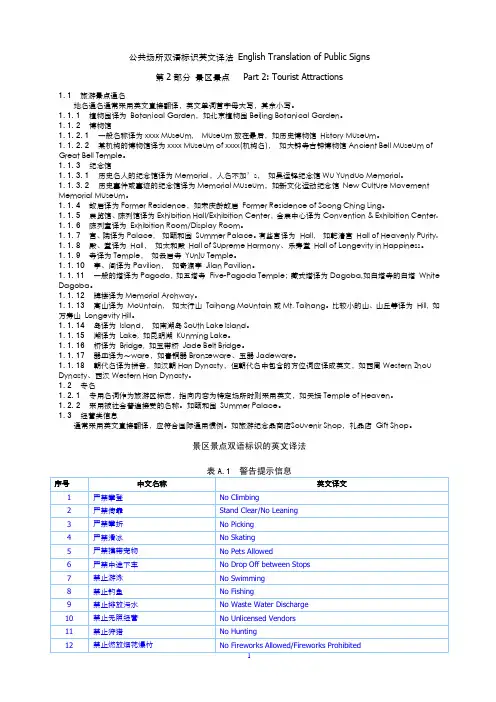
公共场所双语标识英文译法English Translation of Public Signs第2部分景区景点Part2:Tourist Attractions1.1旅游景点通名地名通名通常采用英文直接翻译,英文单词首字母大写,其余小写。
1.1.1植物园译为Botanical Garden,如北京植物园Beijing Botanical Garden。
1.1.2博物馆1.1.2.1一般名称译为xxxx Museum,Museum放在最后,如历史博物馆History Museum。
1.1.2.2某机构的博物馆译为xxxx Museum of xxxx(机构名),如大钟寺古钟博物馆Ancient Bell Museum of Great Bell Temple。
1.1.3纪念馆1.1.3.1历史名人的纪念馆译为Memorial,人名不加’s,如吴运铎纪念馆Wu Yunduo Memorial。
1.1.3.2历史事件或事迹的纪念馆译为Memorial Museum,如新文化运动纪念馆New Culture Movement Memorial Museum。
1.1.4故居译为Former Residence,如宋庆龄故居Former Residence of Soong Ching Ling。
1.1.5展览馆、陈列馆译为Exhibition Hall/Exhibition Center,会展中心译为Convention&Exhibition Center。
1.1.6陈列室译为Exhibition Room/Display Room。
1.1.7宫、院译为Palace,如颐和园Summer Palace。
有些宫译为Hall,如乾清宫Hall of Heavenly Purity。
1.1.8殿、堂译为Hall,如太和殿Hall of Supreme Harmony、乐寿堂Hall of Longevity in Happiness。

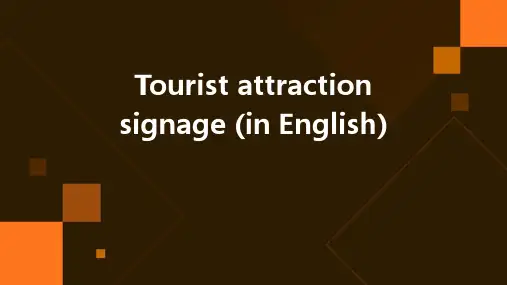

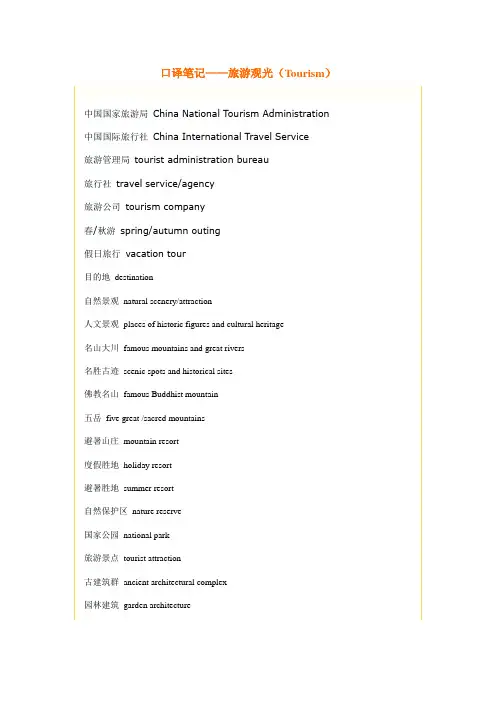
口译笔记——旅游观光(Tourism)中国国家旅游局China National Tourism Administration 中国国际旅行社China International Travel Service旅游管理局tourist administration bureau旅行社travel service/agency旅游公司tourism company春/秋游spring/autumn outing假日旅行vacation tour目的地destination自然景观natural scenery/attraction人文景观places of historic figures and cultural heritage名山大川famous mountains and great rivers名胜古迹scenic spots and historical sites佛教名山famous Buddhist mountain五岳five great /sacred mountains避暑山庄mountain resort度假胜地holiday resort避暑胜地summer resort自然保护区nature reserve国家公园national park旅游景点tourist attraction古建筑群ancient architectural complex园林建筑garden architecture山水风光scenery with mountains and rivers诱人景色inviting views湖光山色landscape of lakes and hills青山绿水green hills and clear waters景色如画picturesque views金石印章metal and stone seals石刻碑文stone inscriptions天下第一泉the finest spring under heaven石舫stone boat水榭waterside house/pavillion莲花池lotus pond国画traditional Chinese painting山水/水墨画landscape/ink painting手工艺品artifact; handicrafts陶器earthenware折扇folding fan木/竹/贝雕wood/bamboo/shell carving联合国教科文组织UNESCO United Nations Educational, Scientific and Cultural Organization国民生产总值GNP gross national product国内生产总值GDP gross domestic product二、例句1.桂林山水甲天下,阳朔山水甲桂林。
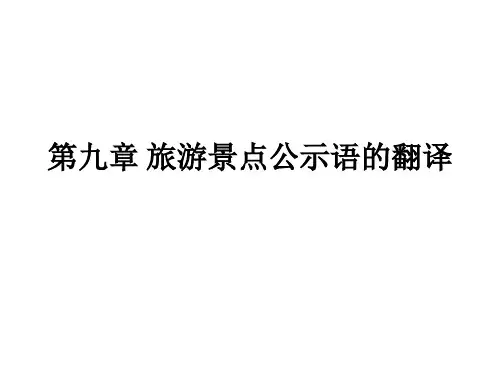
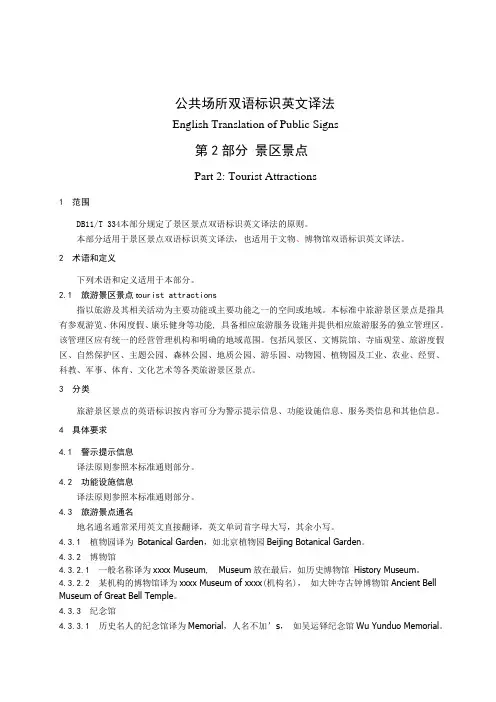
公共场所双语标识英文译法English Translation of Public Signs第2部分景区景点Part 2: Tourist Attractions1 范围DB11/T 334本部分规定了景区景点双语标识英文译法的原则。
本部分适用于景区景点双语标识英文译法,也适用于文物、博物馆双语标识英文译法。
2 术语和定义下列术语和定义适用于本部分。
2.1 旅游景区景点t ourist attractions指以旅游及其相关活动为主要功能或主要功能之一的空间或地域。
本标准中旅游景区景点是指具有参观游览、休闲度假、康乐健身等功能, 具备相应旅游服务设施并提供相应旅游服务的独立管理区。
该管理区应有统一的经营管理机构和明确的地域范围。
包括风景区、文博院馆、寺庙观堂、旅游度假区、自然保护区、主题公园、森林公园、地质公园、游乐园、动物园、植物园及工业、农业、经贸、科教、军事、体育、文化艺术等各类旅游景区景点。
3 分类旅游景区景点的英语标识按内容可分为警示提示信息、功能设施信息、服务类信息和其他信息。
4 具体要求4.1 警示提示信息译法原则参照本标准通则部分。
4.2 功能设施信息译法原则参照本标准通则部分。
4.3 旅游景点通名地名通名通常采用英文直接翻译,英文单词首字母大写,其余小写。
4.3.1 植物园译为Botanical Garden,如北京植物园Beijing Botanical Garden。
4.3.2 博物馆4.3.2.1 一般名称译为xxxx Museum, Museum放在最后,如历史博物馆History Museum。
4.3.2.2 某机构的博物馆译为xxxx Museum of xxxx(机构名),如大钟寺古钟博物馆Ancient Bell Museum of Great Bell Temple。
4.3.3 纪念馆4.3.3.1 历史名人的纪念馆译为Memorial,人名不加’s,如吴运铎纪念馆Wu Yunduo Memorial。
常用旅游翻译词语中英对照旅游翻译的难点主要是了解背景和掌握常用的术语。
以下列出一些旅游翻译中使用频率较高的词语:旅游景点tourist attraction;tourist destination;scenic spot;places of tourist attraction自然景观natural splendor/attraction避暑胜地summer resort国家公园national park出土文物unearthed cultural relics古建筑群ancient architectural complex陵墓emperor's mausoleum/tomb古墓ancient tomb洞穴cave石笋stalagmite钟乳石stalactite石窟grotto坛altar亭pavilion台terrace廊corridor楼tower; mansion庵Buddhist nunnery江河湖泊rivers and lakes池潭ponds and pools堤causeway舫boat榭pavilion;house on a terrace水榭waterside pavilion/house琉璃瓦glazed tile城堡castle教堂church;cathedral宫殿palace;hall;chamber皇城imperial city行宫temporary imperial palace for brief stays御花园imperial garden皇太后empress dowager四大金刚the Four Guardians十八罗汉the Eighteen Disciples of the Buddha甲骨文inscription on oracle bones青铜器bronze ware景泰蓝cloisonne enamel手工艺品artifact;handicrafts苏绣Suzhou embroidery唐三彩tricolor-glazed pottery;ceramics of the Tang Dynasty字画卷轴scroll of calligraphy and painting国画traditional Chinese painting文房四宝the four stationery treasures of the Chinese study including writing brushes,ink sticks,inkstones andpaper工艺精湛,独具匠心exquisite workmanship with an original/ingenious design 湖光山色landscape of lakes and hills依山傍水enclosed/surrounded by the hills on one side and waters on the other 景色如画picturesque views湖石假山lakeside rocks and rockeries山清水秀beautiful mountains and clear waters诱人景色inviting views园林建筑garden architecture佛教名山famous Buddhist mountain丝绸之路the Silk Road/Route。
景区景点双语标识的英文译法(一)A.1警告提示信息表A.1 警告提示信息序号中文名称英文译文1 严禁攀登No Climbing2 严禁倚靠Stand Clear/No Leaning3 严禁攀折No Picking5 严禁携带宠物No Pets Allowed6 严禁中途下车No Drop Off between Stops9 禁止排放污水No Waste Water Discharge10 禁止无照经营No Unlicensed Vendors12 禁止燃放烟花爆竹No Fireworks Allowed/Fireworks Prohibited13 禁止携带易燃易爆物品Inflammables & Explosives Strictly Prohibited14 禁止速降Downhill Skiing Prohibited15 禁止雪道中间停留Don’t Stop on Ski Slope16 禁止由此滑行No Skiing Here17 禁止开窗Keep Windows Closed/Don’t Open Windows18 非机动车禁止入内Motor Vehicles Only19 雷雨天禁止拨打手机Cellphones Prohibited during Thunderstorms20 卧床请勿吸烟Don’t Smoke in Bed21 殿内请勿燃香Don’t Burn Incense in the Hall22 高血压、心脏病患者以及晕车、晕船、酗酒请勿乘坐Drunks, sufferers of hypertension, heart disease and motion sickness not allowed on board.23 防洪通道,请勿占用Flood Control Channel. Keep Clear!24 非游览区,请勿进入No Admittance/No Visitors25 1米以下儿童须家长陪同乘坐Children under 1 meter must be accompanied by an adult.26 酒后不能上船Those under the influence of alcohol not allowed.27 请抬起护栏Please Raise the Guardrail28 请放下护栏Please Lower the Guardrail29 请您不要坐在护栏上边Don’t Sit on Guardrail30 前方弯路慢行Bend Ahead. Slow Down!31 请自觉维护场内卫生环境Please Keep the AreaClean/Please Don’t Litter32 请遵守场内秩序Please Keep Order。
世界旅游景点中英文对照推荐文章泰国中英文地名对照带翻译热度:英文经典歌曲的中英文歌词热度:励志歌曲《Betterman》中英文歌词热度:木兰围场自驾游攻略景点路线热度:汕头免费散心旅游景点热度:下面店铺为大家带来旅游英语之世界旅游景点中英文对照,欢迎大家学习!世界旅游景点中英文对照1:notre dame de paris, france 法国巴黎圣母院effiel tower, france 法国艾菲尔铁塔arch of triumph, france 法国凯旋门elysee palace, france 法国爱丽舍宫louvre, france 法国卢浮宫kolner dom, koln, germany 德国科隆大教堂leaning tower of pisa, italy 意大利比萨斜塔colosseum in rome, italy 意大利古罗马圆形剧场venice, italy 意大利威尼斯parthenon, greece 希腊巴台农神庙red square in moscow, russia 莫斯科红场big ben in london, england 英国伦敦大笨钟buckingham palace, england 白金汉宫hyde park, england 英国海德公园london tower bridge, england 伦敦塔桥westminster abbey, england 威斯敏斯特大教堂monte carlo, monaco 摩洛哥蒙特卡罗the mediterranean 地中海niagara falls, new york state, usa 美国尼亚加拉大瀑布bermuda 百慕大honolulu, hawaii, usa 美国夏威夷火奴鲁鲁panama canal 巴拿马大运河yellowstone national park, usa 美国黄石国家公园statue of liberty, new york city, usa 美国纽约自由女神像times square, new york city, usa 美国纽约时代广场the white house, washington dc., usa 美国华盛顿白宫world trade center, new york city, usa 美国纽约世界贸易中心central park, new york city, usa 美国纽约中央公园yosemite national park, usa 美国尤塞米提国家公园grand canyon, arizona, usa 美国亚利桑那州大峡谷hollywood, california, usa 美国加利佛尼亚好莱坞disneyland, california, usa 加利佛尼亚迪斯尼乐园las vegas, nevada, usa 美国内华达拉斯威加斯miami, florida, usa 美国佛罗里达迈阿密metropolitan museum of art, new york city, usa 纽约大都会艺术博物馆acapulco, mexico 墨西哥阿卡普尔科cuzco, mexico 墨西哥库斯科世界旅游景点中英文对照2:the himalayas 喜马拉雅山great wall, china 中国长城forbidden city, beijing, china 北京故宫mount fuji, japan 日本富士山taj mahal, india 印度泰姬陵angkor wat, cambodia 柬埔寨吴哥窟bali, indonesia 印度尼西亚巴厘岛borobudur, indonesia 印度尼西亚波罗浮屠sentosa, singapore 新加坡圣淘沙crocodile farm, thailand 泰国北榄鳄鱼湖pattaya beach, thailand 泰国芭堤雅海滩babylon, iraq 伊拉克巴比伦遗迹mosque of st, sophia in istanbul (constantinople), turkey 土耳其圣索非亚教堂suez canal, egypt 印度苏伊士运河aswan high dam, egypt 印度阿斯旺水坝nairobi national park, kenya 肯尼亚内罗毕国家公园cape of good hope, south africa 南非好望角sahara desert 撒哈拉大沙漠pyramids, egypt 埃及金字塔the nile, egypt 埃及尼罗河great barrier reef 大堡礁sydney opera house, australia 悉尼歌剧院ayers rock 艾尔斯巨石mount cook 库克山easter island 复活节岛。